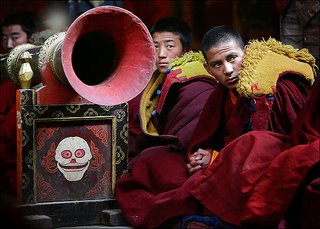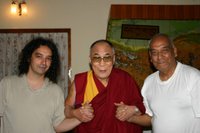 The Dalai Lama Continues
to Hold Sway in Lhasa but
China is Wary of Exiled Spiritual Leader's Politics,
says Edward Cody
in a despatch to
Washington Post
from Lhasa
By Elizabeth Dalziel - AP
The Dalai Lama Continues
to Hold Sway in Lhasa but
China is Wary of Exiled Spiritual Leader's Politics,
says Edward Cody
in a despatch to
Washington Post
from Lhasa
By Elizabeth Dalziel - AP
LHASA, Tibet July 10, 2006:
In the cool of early morning, with heavy clouds still brooding over the surrounding peaks, thousands of pilgrims circled around Jokhang Temple, some spinning prayer wheels and others leading fluffy little dogs. Their silent procession was a vivid display of the deep-seated devotion to Lama Buddhism that persists in Tibet nearly 56 years after the imposition of communist rule in China.
The solemn circumambulation -- wrinkled peasants parading slowly alongside fresh-faced monks in maroon robes - has been a fixture of life in central Lhasa for uncounted years. But the spectacle held special meaning last Thursday morning:
It was the 71st birthday of the Dalai Lama, the exiled Tibetan religious and temporal leader who still holds the hearts of many of Tibet's 2.7 million people.
Chinese authorities have facilitated the pilgrims' worship, saying China has nothing against Buddhism or any other religion as long as it does not spill over into politics. Beijing has allocated millions of dollars for maintenance of Jokhang Temple and the nearby Potala Palace, Lama Buddhism's holiest shrines. But for many Tibetans, particularly the elderly and the monks who make Buddhism their lives, the Dalai Lama has remained the symbol not only of their spiritual world but also of their ethnic identity and national aspirations.
The intermingling of Buddhism's hold on the Tibetan spirit and the Dalai Lama's role as a political as well as religious leader has confronted Chinese authorities with a difficult situation. They have opened up space for worship and pilgrimages, but at the same time they have taken tough measures to prevent Tibetans from coalescing around the Dalai Lama into an organized separatist movement.
A Tibetan middle-school teacher said intense devotion to Buddhism and to the Dalai Lama as a figure of Tibetan independence is most pronounced among the elderly. The Dalai Lama's goal remains Tibet's separation from Chinese rule. A spokesman for the Dalai Lama in Dharamsala, India, queried by the Associated Press, said Chinese officials recently have appeared more flexible.
Large numbers of Tibetans put up photographs of the Dalai Lama in their homes as a sign of loyalty. Security forces discourage displays of the Dalai Lama's photograph but do not scour people's homes looking for them.
Dalai Lama's pictures are banned at the Jokhang Temple. But monks elsewhere in Lhasa furtively showed reporters little photographs of him hanging under their robes like Christian scapulars.
The temple's main image of Buddha, carried by hand litter for three years over the mountains from Xi'an during the Tang Dynasty in the 7th century, is one of the objects of worship that draw pilgrims to Lhasa year after year, temple officials said. Others are artifacts in the Potala Palace, including the throne where the current Dalai Lama, Tenzin Gyatso, the 14th in a sacred line, once sat to rule Tibet.
© Copyright 1996-2006 The Washington Post Company

The above is an abridged version of the report by
Edward Cody and is published as a tribute to the septugenarian spiritual leader. Photograph on right, taken on the Dalai Lama's 70th birthday in Dharamsala, India, shows Editor Ravissant(right) of the
Seniors World Chronicle and his son Bruno (left).
 The Dalai Lama Continues
to Hold Sway in Lhasa but
China is Wary of Exiled Spiritual Leader's Politics,
says Edward Cody
in a despatch to
Washington Post
from Lhasa
By Elizabeth Dalziel - AP
LHASA, Tibet July 10, 2006:
In the cool of early morning, with heavy clouds still brooding over the surrounding peaks, thousands of pilgrims circled around Jokhang Temple, some spinning prayer wheels and others leading fluffy little dogs. Their silent procession was a vivid display of the deep-seated devotion to Lama Buddhism that persists in Tibet nearly 56 years after the imposition of communist rule in China.
The solemn circumambulation -- wrinkled peasants parading slowly alongside fresh-faced monks in maroon robes - has been a fixture of life in central Lhasa for uncounted years. But the spectacle held special meaning last Thursday morning: It was the 71st birthday of the Dalai Lama, the exiled Tibetan religious and temporal leader who still holds the hearts of many of Tibet's 2.7 million people.
Chinese authorities have facilitated the pilgrims' worship, saying China has nothing against Buddhism or any other religion as long as it does not spill over into politics. Beijing has allocated millions of dollars for maintenance of Jokhang Temple and the nearby Potala Palace, Lama Buddhism's holiest shrines. But for many Tibetans, particularly the elderly and the monks who make Buddhism their lives, the Dalai Lama has remained the symbol not only of their spiritual world but also of their ethnic identity and national aspirations.
The intermingling of Buddhism's hold on the Tibetan spirit and the Dalai Lama's role as a political as well as religious leader has confronted Chinese authorities with a difficult situation. They have opened up space for worship and pilgrimages, but at the same time they have taken tough measures to prevent Tibetans from coalescing around the Dalai Lama into an organized separatist movement.
A Tibetan middle-school teacher said intense devotion to Buddhism and to the Dalai Lama as a figure of Tibetan independence is most pronounced among the elderly. The Dalai Lama's goal remains Tibet's separation from Chinese rule. A spokesman for the Dalai Lama in Dharamsala, India, queried by the Associated Press, said Chinese officials recently have appeared more flexible.
Large numbers of Tibetans put up photographs of the Dalai Lama in their homes as a sign of loyalty. Security forces discourage displays of the Dalai Lama's photograph but do not scour people's homes looking for them.
Dalai Lama's pictures are banned at the Jokhang Temple. But monks elsewhere in Lhasa furtively showed reporters little photographs of him hanging under their robes like Christian scapulars.
The temple's main image of Buddha, carried by hand litter for three years over the mountains from Xi'an during the Tang Dynasty in the 7th century, is one of the objects of worship that draw pilgrims to Lhasa year after year, temple officials said. Others are artifacts in the Potala Palace, including the throne where the current Dalai Lama, Tenzin Gyatso, the 14th in a sacred line, once sat to rule Tibet.
© Copyright 1996-2006 The Washington Post Company
The Dalai Lama Continues
to Hold Sway in Lhasa but
China is Wary of Exiled Spiritual Leader's Politics,
says Edward Cody
in a despatch to
Washington Post
from Lhasa
By Elizabeth Dalziel - AP
LHASA, Tibet July 10, 2006:
In the cool of early morning, with heavy clouds still brooding over the surrounding peaks, thousands of pilgrims circled around Jokhang Temple, some spinning prayer wheels and others leading fluffy little dogs. Their silent procession was a vivid display of the deep-seated devotion to Lama Buddhism that persists in Tibet nearly 56 years after the imposition of communist rule in China.
The solemn circumambulation -- wrinkled peasants parading slowly alongside fresh-faced monks in maroon robes - has been a fixture of life in central Lhasa for uncounted years. But the spectacle held special meaning last Thursday morning: It was the 71st birthday of the Dalai Lama, the exiled Tibetan religious and temporal leader who still holds the hearts of many of Tibet's 2.7 million people.
Chinese authorities have facilitated the pilgrims' worship, saying China has nothing against Buddhism or any other religion as long as it does not spill over into politics. Beijing has allocated millions of dollars for maintenance of Jokhang Temple and the nearby Potala Palace, Lama Buddhism's holiest shrines. But for many Tibetans, particularly the elderly and the monks who make Buddhism their lives, the Dalai Lama has remained the symbol not only of their spiritual world but also of their ethnic identity and national aspirations.
The intermingling of Buddhism's hold on the Tibetan spirit and the Dalai Lama's role as a political as well as religious leader has confronted Chinese authorities with a difficult situation. They have opened up space for worship and pilgrimages, but at the same time they have taken tough measures to prevent Tibetans from coalescing around the Dalai Lama into an organized separatist movement.
A Tibetan middle-school teacher said intense devotion to Buddhism and to the Dalai Lama as a figure of Tibetan independence is most pronounced among the elderly. The Dalai Lama's goal remains Tibet's separation from Chinese rule. A spokesman for the Dalai Lama in Dharamsala, India, queried by the Associated Press, said Chinese officials recently have appeared more flexible.
Large numbers of Tibetans put up photographs of the Dalai Lama in their homes as a sign of loyalty. Security forces discourage displays of the Dalai Lama's photograph but do not scour people's homes looking for them.
Dalai Lama's pictures are banned at the Jokhang Temple. But monks elsewhere in Lhasa furtively showed reporters little photographs of him hanging under their robes like Christian scapulars.
The temple's main image of Buddha, carried by hand litter for three years over the mountains from Xi'an during the Tang Dynasty in the 7th century, is one of the objects of worship that draw pilgrims to Lhasa year after year, temple officials said. Others are artifacts in the Potala Palace, including the throne where the current Dalai Lama, Tenzin Gyatso, the 14th in a sacred line, once sat to rule Tibet.
© Copyright 1996-2006 The Washington Post Company
 The above is an abridged version of the report by Edward Cody and is published as a tribute to the septugenarian spiritual leader. Photograph on right, taken on the Dalai Lama's 70th birthday in Dharamsala, India, shows Editor Ravissant(right) of the Seniors World Chronicle and his son Bruno (left).
The above is an abridged version of the report by Edward Cody and is published as a tribute to the septugenarian spiritual leader. Photograph on right, taken on the Dalai Lama's 70th birthday in Dharamsala, India, shows Editor Ravissant(right) of the Seniors World Chronicle and his son Bruno (left).

No comments:
Post a Comment